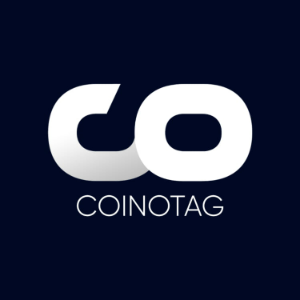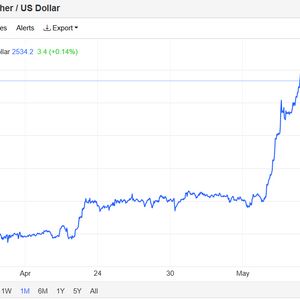VanEck Crypto Monthly Recap For April 2025
19 min read
Summary Crypto markets stumbled early in April, but Bitcoin held strong amid rising institutional interest and shifting macro trends, while token unlocks and speculative fatigue dragged on some alts. Though the 30-day MA of BTC/S&P 500 correlation fell below 0.25 briefly in early April, it quickly regained a correlation of around 0.55 by the end of the month. However, this brief lapse in covariance between BTC and equities did translate into a better BTC return profile than equities. April was a quieter month for Solana, focused on core improvements aligned with its “Increasing Bandwidth, Reducing Latency” roadmap. Crypto markets stumbled early in April, but Bitcoin held strong amid rising institutional interest and shifting macro trends, while token unlocks and speculative fatigue dragged on some alts. Layer 1s (L1S) Have Fallen (-34%) Year-to-Date Source: Market Vectors as of 4/30/2025. The MarketVector™ Smart Contract Leaders Index (MVSCLE) is designed to track the performance of the largest and most liquid smart contract assets. Index performance is not representative of strategy performance. It is not possible to invest directly in an index. Past performance is no guarantee of future results. Not intended as a recommendation to buy or sell any securities named herein. April opened with an unexpected chill in the crypto markets. BTC initially sank as low as $74.5K ( -32% from January 2025 all-time-high) while Altcoins fared worse. SOL ( SOL-USD ) dipped below $95 ( -68% from January 2025 all-time-high), Sui ( SUI-USD ) touched $1.70 (- 68% from January 2025 all-time-high), and ETH ( ETH-USD ) plunged under $1400 (-66% from 4-year highs). The MarketVector Smart Contract Leaders Index (MVSCLE) slipped to 91 ( -59% from its December 2024 high of 220 ). The broader crypto market took on water alongside a sharp global sell-off in risk assets, sparked by a deepening trade dispute. Price Returns April (%) YTD (%) MarketVector Infrastructure Application Leaders Index 26 -37 Coinbase 18 -18 MarketVector Meme Coin Index 16 -48 MarketVector Global Digital Assets Equity Index 15 -28 Bitcoin 13 0 MarketVector Smart Contract Leaders Index 5 -34 Nasdaq Index 1 -10 S&P 500 Index -1 -5 MarketVector Decentralized Finance Leaders Index -1 -57 Ethereum -3 -47 Source: Bloomberg as of 4/30/2025. Index performance is not representative of strategy performance. It is not possible to invest directly in an index. Past performance is no guarantee of future results. Not intended as a recommendation to buy or sell any securities named herein. Even before April, sentiment had already begun to list. Crypto investors absorbed concurrent broadsides from the decline in the DeFi AI, AI Agents, and DeSci sectors, which lost ( -91% ), ( -81% ), and ( -75% ) YTD, respectively. Memecoins also added to the damage as trading volumes dropped ( -93% ) between January and March 2025, while MarketVector’s Memecoin Index showed a loss of ( -55% ) YTD. Crypto investors also struggled to stay afloat under the barrage of relentless token unlocks, with $7.2B hitting the market in January alone and $28B expected by the end of June. When tariffs were announced on April 7, crypto looked ready to sink to Davy Jones’ Locker. BTC fell -500bps relative to stocks that day. But from there, BTC began to show signs of life. On a daily return basis, it outperformed stocks more often than not ( 10 out of 17 sessions) and posted strong gains on up days amid heavy BTC buying. By month-end, BTC was treading water in the mid- $90k range, having retraced over half its January ATH losses. BTC’s buoyancy appears tied to the strengthening sovereign asset narrative, continued expansion of BTC investment products, and renewed risk appetite following pauses in tariff escalation. We also note meaningful corporate accumulation: MSTR ( MSTR ) ( +25.4K BTC ), XXI ( +31.5K ), Metaplanet ( MTPLF ) ( +954 BTC ), and SMLR ( SMLR ) ( +275 BTC ), as well as ETF and fund buying ( +29K BTC ). Altcoins, lacking similar helping currents, struggled to recover amid the implosion of speculative zest. The MarketVector Smart Contract Leaders Index recovered just 19% of their December-to-April losses while ETH clawed back only 16.5% of its drawdown over the same period. Amid the carnage, a few ships avoided the onslaught and gained significant steam. Sui ( +52% ) surged ahead of its annual Base Camp conference. STX ( +22% ) gained on BitGo’s endorsement of its sBTC initiative and its ties to BTC price appreciation. SOL ( +16% ) found support as multiple firms announced plans for Solana-based treasury strategies, and its community put its heads down to improve the network . Bitcoin’s Correlation to Stocks Shows Little Change Crypto Correlation to S&P 500 Index is Still High Source: VanEck Research, Artemis XYZ as of 4/28/2025. Index performance is not representative of strategy performance. It is not possible to invest directly in an index. Past performance is no guarantee of future results. Not intended as a recommendation to buy or sell any securities named herein. In April, many in the crypto community celebrated BTC’s apparent decoupling from broader risk assets, but the data does not fully support this case . Though the 30-day MA of BTC/S&P 500 correlation fell below 0.25 briefly in early April, it quickly regained a correlation of around 0.55 by the end of the month. However, this brief lapse in covariance between BTC and equities did translate into a better BTC return profile than equities. BTC returned ( +13% ) in April while the Nasdaq Composite and S&P 500 returned ( -1% ) and ( +1% ) respectively. More interestingly, the tariff melee caused the volatility of the S&P 500 and Nasdaq to each double over the course of April, while BTC’s volatility actually fell ( -4% ). Going forward, we expect the relationship between equities and BTC to dissolve further as individual investors, corporations, and central banks recognize Bitcoin as a sovereign, uncorrelated store-of-value asset. Countries like Russia and Venezuela have already acknowledged BTC’s developing role in international trade. We believe that many nations will transition some international trade to BTC as a result of Western nations’ overuse of sanctions, the desire to hedge away dollar risk, and the lack of trustworthy alternative currencies. Top 5 Blockchains by Average Daily Revenue Top Chains This Month TRX ($) HYPE ($) SOL ($) ETH ($) BTC ($) Avg Daily Revenue 1,704,424 1,455,743 1,210,862 710,386 533,430 3 Months Ago SOL ($) ETH ($) TRX ($) HYPE ($) BTC ($) Avg Daily Revenue 8,184,682 4,832,461 1,820,250 1,722,981 663,422 6 Months Ago ETH ($) SOL ($) BTC ($) TRX ($) BNB ($) Avg Daily Revenue 4,512,295 2,453,933 1,570,891 1,566,830 343,967 9 Months Ago ETH ($) SOL ($) TRX ($) BTC ($) BNB ($) Avg Daily Revenue 3,099,851 1,752,622 1,349,523 777,232 360,772 12 Months Ago BTC ($) ETH ($) SOL ($) TRX ($) BNB ($) Avg Daily Revenue 9,382,056 7,352,098 1,694,517 1,327,356 708,056 Source: VanEck Research as of 4/29/2025. Past performance is no guarantee of future results. Not intended as a recommendation to buy or sell any securities named herein. Remarkably, onchain activity measured by blockchain revenues, stablecoin transfer volume, and DEX volumes was robust despite the token price drawdowns. Compared to March 2025’s figures, total blockchain revenue was (+ 0.5% ) , stablecoin transfer volume was ( +11% ) , and DEX volume was ( +5% ) compared to April’s values. Tron, a general purpose blockchain who derives most of its activity from stablecoin transfers, and Hyperliquid, a blockchain focused on trading applications, respectively earned the first and second most revenue amongst smart contract platforms (SCPS) in April. This marks the second consecutive month where Tron and Hyperliquid earned more onchain revenue than Solana earned. Another notable event in April was Ethereum’s reversal in asset movement trends. After previously ranking among the blockchains with the most outflows, it became the top recipient of asset inflows from other blockchains. Ethereum received most of its inflows from its L2s, chiefly Arbitrum and Optimism, while Ethereum’s assets left Mainnet for Base and Sonic. More Firms Replicate Saylor’s Strategy BTC Price Tends to Drive MSTR Premium Source: VanEck Research, Strategy as of 4/28/2025. Past performance is no guarantee of future results. Not intended as a recommendation to buy or sell any securities named herein. A crypto narrative that flowered amid the downpour of negativity in April was the sprouting of new firms replicating Saylor’s BTC Treasury Strategy. Until Michael Saylor launched the Bitcoin ((BTC)) treasury strategy in 2020, most corporate BTC holders were crypto-native firms such as miners, trading companies, and exchanges. That changed when companies like Block ( 8.48K BTC) and Tesla ( 11.5K BTC) began accumulating BTC as a core treasury asset. Most recently, GameStop ( GME ) announced plans to allocate part of its $1.5B capital raise to BTC purchases. Currently, total corporate BTC treasury holdings stand at approximately 1.05 million BTC. We trace the renewed interest in Saylor’s strategy to the persistent premium embedded in Strategy ( MSTR ) stock. MSTR trades at a 119% premium to the combined value of its BTC holdings and enterprise software business. This phenomenon has attracted other firms such as Metaplanet (Japan, 5K BTC) and Semler Scientific (USA, 3.3K BTC) to engage in Bitcoin strategies. Semler trades at approximately 1.07 times its BTC NAV, while Metaplanet trades around 2.25 times. In April, Softbank ( SFTBY ), Tether, and Cantor Fitzgerald launched a joint venture called XXI, with initial holdings of 31.5K BTC. Companies have also expanded beyond BTC to accumulate other tokens. DeFi Development Corp (formerly Janover) increased its SOL holdings to 317K tokens valued at $47M and announced plans to raise to $1B more in SOL. Upexi ( UPXI ), another Nasdaq-listed firm, said it would raise $100M , largely for SOL accumulation. In Canada, SOL Strategies announced a $500M note facility to purchase SOL to back its shares. While this financialization trend reflects growing institutional interest in digital assets, we cautiously approach its broad adoption. As more firms seek exposure through capital markets, it may introduce added volatility to BTC and other crypto assets. We will explore this dynamic further in an upcoming blog post on MicroStrategy. Name Bitcoin (₿) Microstrategy, Inc. 553,555 MARA Holdings, Inc. ( MARA ) 47,600 XXI 31,500 Riot Platforms, Inc. ( RIOT ) 19,223 Galaxy Digital Holdings Ltd ( BRPHF ) 13,704 CleanSpark, Inc. ( CLSK ) 11,869 Tesla, Inc. ( TSLA ) 11,509 Hut 8 Mining Corp ( HUT ) 10,273 Coinbase Global, Inc. ( COIN ) 9,480 Block, Inc. ( XYZ ) 8,485 Source: BitcoinTreasuries.Net as of 4/28/2025. Past performance is no guarantee of future results.Not intended as a recommendation to buy or sell any securities named herein. April’s Notable Performers – Solana (+16%) and SUI (+52%) Solana spends April building Solana Decentralized Exchange (DEX) Volume is Driven by Memecoins April was a quieter month for Solana, focused on core improvements aligned with its “Increasing Bandwidth, Reducing Latency” (IBRL) roadmap. The chain released SIMD-0207, raising the block compute limit to 50M , up from 48M , a ( +4% ) increase. This enables higher transaction throughput and sets the stage for SIMD-0256, which could raise the limit to 60M . In effect, a higher compute limit expands block size and network capacity. The Solana Foundation also reassessed its validator delegation program, which allocates over 70M SOL, roughly 18% of total staked SOL. Some community members have raised concerns about centralization and possible favoritism. In response, Solana will begin removing validators with less than 1,000 SOL in external stake who have relied on Foundation support for more than 18 months. Three underperforming validators will be phased out for every new validator onboarded to the Solana Foundation delegation program. The program aims to encourage validators to deliver services beyond basic validation. Many already offer tools like blockchain scanners that serve the community at no cost. These contributions raise a validator’s profile and help attract stake. In short, the Foundation is rewarding those who add value to the ecosystem and phasing out those who do not. Meanwhile, memecoins remain the primary driver of onchain revenues. In January 2025, they accounted for 44% of decentralized exchange trading volume, and 35% in April 2025. If we exclude stablecoins, SOL, and SOL liquid staking tokens, often on the other side of trades, memecoins represent 99% of Solana trading activity in January and 95% in April. While some question the sustainability of this trend, Solana has proven its unmatched ability to process large volumes of decentralized trading. This positions Solana as the most likely home for the next breakout trading application. SUI’s near-term velocity is impressive Average Daily Decentralized Exchange (DEX) Volume for April 2025 Source: Artemis XYZ as of 4/30/2025. Past performance is no guarantee of future results. Not intended as a recommendation to buy or sell any securities named herein. We have extensively covered the potential of Sui’s blockchain and find it compelling based on its rockstar leadership team, novel high-performance architecture, and continued output of interesting products. Blockchains are extremely competitive businesses, and one of the only moats is a project’s ability to ship new, useful features. Sui continues to deliver with tools like Walrus, a decentralized storage protocol; Deepbook, a chain-wide liquidity pool for all assets; Seal, a data access control tool; and Nautilus, an off-chain computation verifier. Even the most avid crypto user may find the value of these tools hard to assess, but each was created to solve specific developer problems based on user feedback. In our discussions with teams building on Sui, many point to the responsiveness of Mysten Labs, the core developers behind the network. This drive to make things that matter to developers is one of the key features differentiating Sui from other SCPs. Sui’s fundamentals in April reflect its price momentum. DEX volumes jumped ( +45.5% ) to a daily average of $374M , up from March, making Sui the 6th highest trading blockchain. On the revenue front, Sui ranked 9 th among SCPs, generating an average of $44K per day. Its stablecoin supply remains relatively small at $885M , placing it 12 th by onchain stablecoin value. Still, Sui ranks 1st in stablecoin turnover ratio at 716% (stablecoin transfer volume/stablecoin market cap), just ahead of Base at 602% . April’s Notable Laggards – Ethereum (-3%) and XRP (+5%) ETH + L2s Share of Fees Hit Multi-Year Lows in April Source: Artemis as of 4/30/2025. Past performance is no guarantee of future results. Not intended as a recommendation to buy or sell any securities named herein. Ethereum’s ETH ( -3% ) continued to lag this month as faster chains like Solana ( +16% ) and Sui ( +52% ) gained market share during the latest rally. Unfortunately for Ethereum, this marks a continuation of a grim, longer-term trend: its share of blockchain transaction fees dropped from ( -74.1% ) two years ago to just 13.7% of all smart contract platform (SCP) revenues. In our opinion, the market is sending a clear signal: users, applications, and fees are migrating to faster, cheaper chains. In response, Ethereum developers are advancing several initiatives to scale the network and simplify its execution layer dramatically. Ethereum L1 Developments Vitalik Buterin’s RISC-V Proposal: Vitalik Buterin has proposed replacing Ethereum’s Virtual Machine ((EVM)) with the RISC-V architecture. This move to RISC-V could simplify Ethereum’s execution layer, boost transaction speeds, and dramatically improve zero-knowledge proof (ZKP) efficiency. Today, proving a single Ethereum block takes around 4.7 minutes; with RISC-V, researchers hope to cut this down by up to 100x, unlocking sub-5-second proving times critical for scaling ZK rollups. The proposal also aims to enhance competition among block producers while maintaining Solidity and Vyper compatibility. However, implementing RISC-V would require rebuilding major sections of Ethereum’s core code and could take years. EIP-9698: 100x Gas Limit Increase: Ethereum researcher Dankrad Feist proposed EIP-9698, which would increase the gas limit by 100x over four years. This change could raise throughput from today’s 15–20 transactions per second (TPS) to around 2,000 TPS by 2029. Instead of a hard fork, the upgrade would use a deterministic, exponential schedule baked into Ethereum client defaults, allowing validators to upgrade hardware gradually. If approved, the changes could start on June 1. Access Lists for Parallelization: EIP-9580 introduces block-level access lists to enable parallel transaction processing. By predefining which accounts and storage slots are accessed, Ethereum could dramatically cut validation times, allowing for simultaneous disk reads and EVM execution. This is similar to how Solana works under the hood. This would improve performance, especially under network congestion. These L1 initiatives reflect a growing focus on reasserting control over the Ethereum ecosystem’s economics. As the Ethereum ecosystem’s Layer 2s have scaled, they have increasingly taken user activity and transaction fees from the L1, even though Ethereum continues to provide core security and data availability infrastructure. Recently, Flashblocks’ launch on OP Superchain networks like Base, Unichain, and Optimism reduced confirmation times to 200ms down from 2s. Additionally, Arbitrum upgraded its blockchain to enable gas to be paid in tokens other than Ethereum. Taken together, these moves embody the tension between Ethereum and its L2s. Flashbots will arguably draw more activity away from Ethereum’s Mainnet, while Arbitrum’s new proposal may reduce the importance of ETH in the L2s that are built using Arbitrum’s tech stack. With ETH prices continuing to lag other major cryptocurrencies, the market increasingly recognizes L2s as economically parasitic to L1. This tension has led to the urgency in the Ethereum Foundation’s efforts to reclaim fee share and reinforce ETH’s value proposition as an asset. At the same time, many L2s are pursuing their own priorities, setting the stage for a growing divergence in strategy. We applaud Ethereum’s effort and scaling of its blockchain, but we urge it to make more rapid changes. The competition, such as Solana and Sui, responds quickly to user needs with tight feedback loops that can be measured in weeks or months. Ethereum must consider the threats these new chains pose as terminal and match the cadence of its competitors. XRP barely budges despite Ripple’s shift Driven by DeFi Demand on Ethereum, RLUSD Supply Crossed 300M in April Source: Ripple as of 5/2/2025. Past performance is no guarantee of future results. Not intended as a recommendation to buy or sell any securities named herein. April saw XRP underperform despite Ripple’s efforts to reposition its network through several key moves. For years, many dismissed Ripple as a speculative asset with little real usage. Recently, however, it has shifted toward smart contracts, a dollar-pegged stablecoin, and major acquisitions to drive activity on its chain. Ripple began April by integrating RLUSD, its enterprise-grade stablecoin, into Ripple Payments, a platform offering institutions fast, low-cost, blockchain-assisted cross-border transactions. According to data from Ripple, RLUSD supply crossed $300M by month-end, growing 30% month-over-month. However, with roughly 79% of RLUSD issued on Ethereum, it’s unclear how much of this growth stems from DeFi activity versus enterprise usage. Issued by a NYDFS-regulated limited-purpose trust company, RLUSD arguably offers stronger compliance oversight than USDT or even USDC. Just one week after RLUSD’s integration, Ripple announced a $1.25B acquisition of Hidden Road, one of the largest deals in digital assets to date. Hidden Road plans to use RLUSD for cross-margining between traditional and digital assets, a key utility for prime brokers who move trillions in collateral daily. Ripple also intends to migrate Hidden Road’s post-trade activity onto the XRP Ledger, positioning XRPL as a foundational layer for institutional finance. In a joint report released the same week, Ripple and Boston Consulting Group projected the tokenized real-world asset market could grow from $600B today to $18.9T by 2033, a +53% compound annual growth rate ( CAGR ) . Ripple’s actions show a clear conviction in this thesis and its intent to benefit if it plays out. If successful, Ripple may become a case study in transforming a speculative token into a world-class business. With over 40% of XRP’s supply, Ripple holds a war chest worth $100B to fund future acquisitions. As April closed, rumors surfaced that Ripple offered $4–5B to acquire Circle, ahead of Circle’s expected IPO. Though XRP underperformed this month, it remains a standout long-term performer, up ( +340% ) YoY, compared to an ( -8% ) decline in the MarketVector Smart Contract Leaders Index . In the competitive world of crypto, Ripple has succeeded where technically superior blockchains have failed. Its durability comes from a consistent narrative, strong leadership, and an unmatched community of XRP holders. Disclosures Index Definitions S&P 500 Index: is widely regarded as the best single gauge of large-cap U.S. equities. The index includes 500 leading companies and covers approximately 80% of available market capitalization. Nasdaq 100 Index: is comprised of 100 of the largest and most innovative non-financial companies listed on the Nasdaq Stock Market based on market capitalization. MarketVector Centralized Exchanges Index: designed to track the performance of assets classified as ‘Centralized Exchanges’. MarketVector Decentralized Finance Leaders Index: designed to track the performance of the largest and most liquid decentralized financial assets, and is an investable subset of MarketVector Decentralized Finance Index. MarketVector Media & Entertainment Leaders Index: designed to track the performance of the largest and most liquid media & entertainment assets, and is an investable subset of MarketVector Media & Entertainment Index. MarketVector Smart Contract Leaders Index: designed to track the performance of the largest and most liquid smart contract assets, and is an investable subset of MarketVector Smart Contract Index. MarketVector Infrastructure Application Leaders Index: designed to track the performance of the largest and most liquid infrastructure application assets, and is an investable subset of MarketVector Infrastructure Application Index. MarketVector Digital Assets 100 Large-Cap Index: market cap-weighted index which tracks the performance of the 20 largest digital assets in The MarketVector Digital Assets 100 Index. MarketVector Digital Assets 100 Small-Cap Index: market cap-weighted index which tracks the performance of the 50 smallest digital assets in The MarketVector Digital Assets 100 Index. MarketVector Meme Coin Index: modified market cap-weighted index which tracks the performance of the 6 largest meme coins. Meme coin refers to crypto assets often named after characters, individuals, animals, artworks, or other memetic elements. Initially supported by enthusiastic online traders and communities, these coins are intended for entertainment purposes. Coin Definitions Bitcoin (BTC): A decentralized digital currency enabling peer-to-peer transactions without intermediaries or a central authority. Ethereum (ETH): A decentralized platform that enables smart contracts and decentralized applications (dApp S ) using its native token, Ether. Solana (SOL): A high-performance blockchain using Proof-of-History and Proof-of-Stake to support fast, low-cost dApps and decentralized finance. BNB (BNB): The native token of the BNB Chain ecosystem (formerly Binance Smart Chain), used for gas fees, staking, and DeFi applications. Avalanche (AVAX): A highly scalable smart contract platform designed for speed and low fees, supporting custom subnets and DeFi applications. Cardano (ADA): A proof-of-stake blockchain emphasizing academic research and peer-reviewed development; used for dApps and token issuance. Polkadot (DOT): A multichain network that enables interoperability between blockchains via parachains and a central relay chain. Tron (TRX): A blockchain platform focusing on digital entertainment and content sharing, enabling low-cost transactions and USDT transfers. Toncoin (TON): A layer-1 blockchain originally developed by Telegram, optimized for scalability, speed, and integration with the messaging app. Sui (SUI): A high-throughput, low-latency Layer 1 blockchain designed for parallel transaction execution and on-chain asset management. Near Protocol (NEAR): A Layer 1 blockchain with a sharded architecture designed for developer-friendly applications, recently pivoting toward AI and intent-based trading. Hedera (HBAR): A proof-of-stake network using a unique hashgraph consensus algorithm, focused on enterprise-grade decentralized applications. Mantle (MNT): A modular Ethereum Layer-2 solution using Optimistic Rollups and Alt-DA to improve scalability and cost-efficiency. Base: A Coinbase-backed Ethereum Layer-2 using Optimistic Rollups to offer fast, low-cost transactions within a regulated environment. Scroll: An Ethereum Layer-2 network utilizing zk-rollups for enhanced security, scalability, and faster transaction speeds. EigenDA: A decentralized data availability layer leveraging Ethereum validators to offer scalable, modular rollup infrastructure. Celestia (TIA): A modular blockchain focused on providing decentralized data availability for Layer-2 rollups and other chains. Uniswap (UNI): A leading decentralized exchange (DEX) on Ethereum that uses an automated market maker (AMM) model for permissionless token swaps. Chainlink (LINK): A decentralized oracle network that connects smart contracts to real-world data sources and APIs via secure data feeds. Gnosis (GNO): An Ethereum-based platform specializing in prediction markets and DeFi tools, governed by the GNO token. XRP (Ripple): A digital asset designed for cross-border payments, developed by Ripple Labs, with a focus on enterprise and financial institutions. HEX: A controversial token marketed as a high-yield savings product built on Ethereum; subject to regulatory scrutiny and legal action. Hyperliquid (HYPE): A hybrid L1 and L3 system optimized for decentralized perpetual futures trading with Ethereum compatibility. RLUSD – Ripple’s enterprise-grade stablecoin issued via Ripple Payments. Stacks (STX): A Bitcoin layer-2 protocol that enables smart contracts and decentralized applications to operate on the Bitcoin network, using Bitcoin as the settlement layer. Arbitrum (ARB): An Ethereum layer-2 scaling solution that uses optimistic rollups to provide faster, lower-cost transactions while remaining compatible with the Ethereum Virtual Machine (EVM). Optimism (OP): An Ethereum layer-2 network leveraging optimistic rollups to reduce fees and latency for dApps while supporting Ethereum-native tooling and infrastructure. Sonic: A Solana-based layer-2 architecture designed for ultra-low-latency, high-throughput execution, optimized for Solana-native applications and modular deployments. (Note: No native token as of now.) Unichain: A modular Ethereum rollup tailored for MEV-aware applications, focused on enabling custom block production logic and efficient settlement within the Ethereum ecosystem. (Note: No native token as of now.) Risk Considerations This is not an offer to buy or sell, or a recommendation to buy or sell any of the securities, financial instruments or digital assets mentioned herein. The information presented does not involve the rendering of personalized investment, financial, legal, tax advice, or any call to action. Certain statements contained herein may constitute projections, forecasts and other forward-looking statements, which do not reflect actual results, are for illustrative purposes only, are valid as of the date of this communication, and are subject to change without notice. Actual future performance of any assets or industries mentioned are unknown. Information provided by third party sources are believed to be reliable and have not been independently verified for accuracy or completeness and cannot be guaranteed. VanEck does not guarantee the accuracy of third party data. The information herein represents the opinion of the author(s), but not necessarily those of VanEck or its other employees. Index performance is not representative of fund performance. It is not possible to invest directly in an index. In vestments in digital assets and Web3 companies are highly speculative and involve a high degree of risk. These risks include, but are not limited to: the technology is new and many of its uses may be untested; intense competition; slow adoption rates and the potential for product obsolescence; volatility and limited liquidity, including but not limited to, inability to liquidate a position; loss or destruction of key(s) to access accounts or the blockchain; reliance on digital wallets; reliance on unregulated markets and exchanges; reliance on the internet; cybersecurity risks; and the lack of regulation and the potential for new laws and regulation that may be difficult to predict. Moreover, the extent to which Web3 companies or digital assets utilize blockchain technology may vary, and it is possible that even widespread adoption of blockchain technology may not result in a material increase in the value of such companies or digital assets. Digital asset prices are highly volatile, and the value of digital assets, and Web3 companies, can rise or fall dramatically and quickly. If their value goes down, there’s no guarantee that it will rise again. As a result, there is a significant risk of loss of your entire principal investment. Digital assets are not generally backed or supported by any government or central bank and are not covered by FDIC or SIPC insurance. Accounts at digital asset custodians and exchanges are not protected by SPIC and are not FDIC insured. Furthermore, markets and exchanges for digital assets are not regulated with the same controls or customer protections available in traditional equity, option, futures, or foreign exchange investing. Digital assets include, but are not limited to, cryptocurrencies, tokens, NFTs, assets stored or created using blockchain technology, and other Web3 products. Web3 companies include but are not limited to, companies that involve the development, innovation, and/or utilization of blockchain, digital assets, or crypto technologies. All investing is subject to risk, including the possible loss of the money you invest. As with any investment strategy, there is no guarantee that investment objectives will be met and investors may lose money. Diversification does not ensure a profit or protect against a loss in a declining market. Past performance is no guarantee of future performance. © Van Eck Associates Corporation. Original Post Editor’s Note: The summary bullets for this article were chosen by Seeking Alpha editors.

Source: Seeking Alpha



